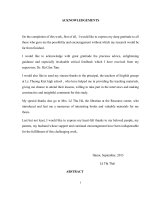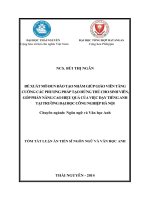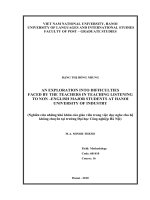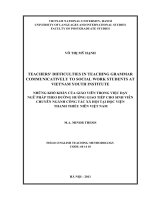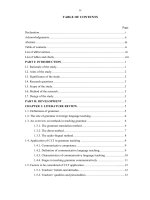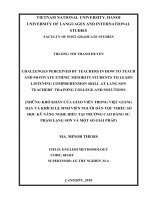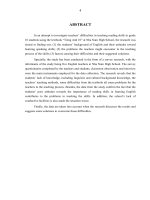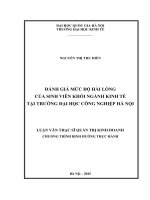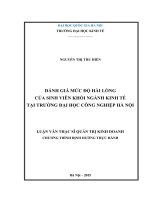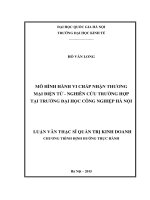Nghiên cứu những khó khăn của giáo viên trong việc dạy nghe cho hệ không chuyên tại trường Đại học Công nghiệp Hà Nội
Bạn đang xem bản rút gọn của tài liệu. Xem và tải ngay bản đầy đủ của tài liệu tại đây (1.67 MB, 51 trang )
VIET NAM NATIONAL UNIVERSITY, HANOI
UNIVERSITY OF LANGUAGES AND INTERNATIONAL STUDIES
FACULTY OF POST – GRADUATE STUDIES
ĐẶNG THỊ HỒNG NHUNG
AN EXPLORATION INTO DIFFICULTIES
FACED BY THE TEACHERS IN TEACHING LISTENING
TO NON –ENGLISH MAJOR STUDENTS AT HANOI
UNIVERSITY OF INDUSTRY
(Nghiên cứu những khó khăn của giáo viên trong việc dạy nghe cho hệ
không chuyên tại trường Đại học Công nghiệp Hà Nội)
M.A. MINOR THESIS
Field: Methodology
Code: 601410
Course: 16
Hanoi - 2010
VIET NAM NATIONAL UNIVERSITY, HANOI
UNIVERSITY OF LANGUAGES AND INTERNATIONAL STUDIES
FACULTY OF POST – GRADUATE STUDIES
ĐẶNG THỊ HỒNG NHUNG
AN EXPLORATION INTO DIFFICULTIES
FACED BY THE TEACHERS IN TEACHING LISTENING
TO NON –ENGLISH MAJOR STUDENTS AT HANOI
UNIVERSITY OF INDUSTRY
(Nghiên cứu những khó khăn của giáo viên trong việc dạy nghe cho hệ
không chuyên tại trường Đại học Công nghiệp Hà Nội)
M.A. MINOR THESIS
Field: Methodology
Code: 601410
Course: 16
Supervior: Phạm Minh Tâm, M.Ed
Hanoi - 2010
iii
TABLE OF CONTENTS
Page
Certificate i
Acknowledgements ii
Table of contents iii
List of tables, charts and pie charts v
CHAPTER I: INTRODUCTION 1
1.1. Rationale for the study and research problem statement 2
1.2. Aims of the study 2
1.3. Methodology 2
1.4. Scope of the study 2
1.5. Significance of the study 2
1.6. Design of the study 3
CHATER 2: LITERATURE REVIEW 4
2.1. Definitions of Listening 4
2.2. Nature of Listening Comprehension 6
2.2.1. Listening Comprehension 6
2.2.2. Listening Process 7
2.2.3. The Features of Spoken English 9
2.3. Procedure of Listening Lessons 11
2.3.1. Pre – listening stage 11
2.3.2. While – listening stage 12
2.3.3. Post – listening stage 13
2.4. Roles of Teachers in Listening Lessons 13
2.5. An Overview of Common Difficulties in Teaching Listening 14
2.6. Previous Studies 14
2.7. Conclusive Remarks 15
CHAPTER 3: METHODOLOGY 16
3.1. Research Context 16
3.2. Research Questions 16
iv
3.3. Research Approach 16
3.4. Participants 17
3.5. Data Collection Instrument 17
3.6. Data Collection Procedure 17
3.7. Data Analysis Procedure 18
CHAPTER 4: DATA ANALYSIS AND DISCUSSIONS 19
4.1. Data Analysis and Results 19
4.1.1. The teachers’ opinions towards teaching listening comprehension 19
4.1.2. The teachers’ perception of factors making their teaching of listening
difficult 19
4.1.3. The teachers’ perception towards the importance of the features of
spoken English in learning listening comprehension 20
4.1.4. The teachers’ exploitation of the features of spoken English into
teaching listening 21
4.1.5. The teachers’ activities in pre – listening stage 23
4.1.6. The teachers’ activities in while– listening stage 24
4.1.7. The teachers’ activities in post – listening stage 25
4.1.8. The teachers’ exploitation of teaching aids 26
4.1.9. The teachers’ exploitation of the listening materials 27
4.2. Findings and Discussion 28
4.2.1. The teachers’ lack of experience in teaching 28
4.2.2. The inefficiency in the teaching methodology 28
4.2.3. The teachers’ limitations in exploiting teaching materials and
teaching aids 30
CHAPTER 5: SUGGESTIONS AND RECOMENDATIONS 31
5.1. Developing the listening materials 31
5.2. Encouraging the students’ internal factors 32
5.3. Combining intensive listening with extensive listening 32
5.4. Applying three stages in teaching listening effectively 33
5.5. Teaching listening strategies for students 34
5.6. Combining teaching listening comprehension with teaching other aspects
of English 36
v
CHAPTER 6: CONCLUSION 36
6.1. Summary of the findings 36
6.2. Limitations and suggestions for further study 37
REFERENCES
APPENDIX
vi
LIST OF TABLES AND PIE CHARTS
List of pie charts
Page
Pie chart 1:
The teachers’ view of the importance of teaching listening comprehension
compared with other skills
14
List of tables
Table 1:
The teachers’ perception of factors making their teaching difficult
14
Table 2:
The teachers’ perception towards the importance of the features of spoken
English in learning listening comprehension
15
Table 3:
The teachers’ exploitation of the features of spoken English into teaching
listening
16
Table 4:
The teachers’ activities in Pre – listening stage
16
Table 5:
The teachers’ activities in while listening stage
19
Table 6:
The teachers’ activities in post – listening stage
20
Table 7:
The teachers’ use of teaching aids in teaching listening comprehension
21
Table 8:
The teachers’ exploitation of the course books
22
1
CHAPTER 1: INTRODUCTION
1.1. Rationale for the study and research problem statement
As an international language, English has been remarked with many changes,
notably the changes in the movement towards the teaching of English. Teaching and
learning English in Vietnam is not excluded from the international trend as Vietnam is
broadening and improving the relationship and co – operation with other countries in many
fields of life. As a result, English has become a compulsory subject at various schools and
universities.
Teaching a foreign language refers to teaching different aspects including: grammar,
pronunciation, vocabulary and four skills which are: writing, reading, speaking and
listening. These different aspects are equally significant in mastering a language and they
should be developed thoroughly.
Along with other skills, listening has been of great importance as Brett (1997, p.39)
stated that “listening is a key language skill, it has a vital role in the language acquisition
process”. The research by Morley (2001) concluded that average people can expect to
listen “twice as much as we speak, four times more than what we read and five times more
than we usually write”. In addition, Michael Lewis (1993, p.32) emphasized that “Almost
all the world‟s natural language output is spoken rather written”. Therefore, there has also
been an increase in the number of studies on the role of listening in communication and in
language learning (Dunkel, 1991; Anderson and Lynch, 1988).
Listening provides input, consequently, improving listening ability helps to widen
students‟ input. Thus, teaching listening effectively is very necessary and important in
order to support students‟ input and improve students‟ language acquisition. However,
listening seems to get less attention by a number of learners as they suppose that listening
is the most difficult skill among four skills. At Hanoi University of Industry (HaUI),
listening is a big challenge for many first year students who rarely have chance to practice
listening at high schools. The students have the habit of ignoring listening which makes the
teaching of listening become a challenge for the teachers. Moreover, the ineffectiveness in
teaching listening is the key reason that creates troubles for the teachers in their work.
2
1.2. Aims of the Study
The study is intended to examine the teachers‟ difficulties in teaching listening
comprehension to the first students. The study will find the answers to the following
questions:
1. What are the difficulties as perceived by the teachers in teaching
listening at Hanoi University of Industry?
2. What are the possible suggestions and recommendations to overcome
the difficulties perceived by the teachers in teaching listening comprehension?
1.3. Methodology
The study was conducted in accordance with the survey approach. That is because
the study focused on the teachers‟ attitude at HaUI towards the teaching of listening
comprehension to find out their difficulties. The data was collected from the survey
questionnaire done on 30 full time teachers of English at HaUI.
1.4. Scope of the study
This minor thesis was conducted in Hanoi University of Industry in order to
investigate the difficulties as perceived by the teachers in teaching listening
comprehension. The study focused on surveying the methods that the teachers at HaUI use
to teaching listening comprehension which has created troubles for themselves. The thesis
also offered some suggestions and recommendations to overcome the problems.
1.5. Significance of the study
This study contributed to list out the difficulties faced by the teachers at Hanoi
University of Industry in teaching listening comprehension. More importantly, the results
of the research are believed to serve the purpose of improving the teaching of listening to
the first year students at Hanoi University of Industry (HaUI)
1.6. Design of the study
The study contains of six chapters
Chapter 1:
presents the background, the significance, the aims and scope of the study
Chapter 2:
presents the theoretical background relevant to the study
Chapter 3:
describes the setting of the study which is the current situation of teaching
and learning listening comprehension at Hanoi, University of Industry.
Chapter 4:
deals with analyzing the data collected
3
Chapter 5:
provides the findings of the study and recommends suggestions for
improving the teaching of listening comprehension at HaUI
Chapter 6:
gives the summary of the thesis and suggestions for further study
4
CHAPTER 2: LITERATURE REVIEW
2.1. Definitions of listening
Listening is one of the four important skills in learning a foreign language which are:
Listening, Speaking, Reading and Writing. For years, listening and reading were thought of
as passive skills while speaking and writing were active skills. Indeed, until the late 1970s,
listening received not much attention as other skills. Present studies on listening have
different views from the former one. According to Helgesen (2003, p.24) “listening is an
active, purposeful of making sense of what we hear”. Similarly, Rubin (1995, p.7) defined
listening as “an active process of understanding speech in which listeners select and
interpret information which comes from auditory and visual clues in order to define what is
going on and what the speakers are trying to express”. Following Anderson and Lynch„s
definition (1988), “listening is really a receptive skill along side reading skills and the role
of the listeners is no – longer passive but active”.
Listening is quite different from hearing. In Cambridge Advanced Learners‟
Dictionary, listening is defined as “to give attention to someone or something in order to
hear them” while hearing is defined as “the ability to hear”. In other words, “listening
requires the active attention – and an active intention – on the part of the hearer”.
(Helgesen, 2003, p. 4)
In teaching listening, it is necessary to mention about listening skills and listening
strategies. Rost (1991) emphasized the skills necessary for listening comprehension which
are perception skill (for example: discriminating between sounds or recognizing words…),
analysis skill (such as identifying grammatical grouping of words) and synthesis skill (for
instance: connecting linguistic cues like intonation and stress and non – linguistic cues like
gestures and relevant objects to construct the meaning of spoken texts. In addition, Rost
(1991) mentioned about using background knowledge and context to predict and
understand spoken texts. These above factors make up a person‟s listening ability. Thus, in
order to improve learners‟ listening skill, teachers should encourage their students to use
listening strategies which help them become better listeners. “Strategies are effort to
compensate for uncertainties in understanding, and could include inferences, realizing
where misunderstandings have occurred, and asking for clarification.” (Mary Underwood,
5
1989, p. 9). According to Michael Berman (2003, p. 2), there are key strategies improving
listening ability which are: predicting, identifying main ideas, note taking, processing
details, guessing vocabulary from context. The strategies should not be separated from the
content teaching so that learners can see the applications of them to the development of
listening ability.
2.2. Nature of listening comprehension
2.2.1 Listening comprehension
Listening comprehension has been defined by various researchers, in which Gary
Buck gave a definition in very clear words. According to Gary Buck (2001, p.31),
“listening comprehension is an active process of constructing meaning and this is done by
applying knowledge to the incoming sound” in which “number of different types of
knowledge are involved: both linguistic and non – linguistic knowledge”. He supposed that
“comprehension is affected by a wide range of variables, and that potentially any
characteristic of the speaker, the situation or the listener can affect the comprehension of
the message”. (Gary Buck, 2001, p.31)
There do exist controversies on the nature of listening comprehension. According to
Anderson and Lynch (1988), there are two influential views: traditional view and
alternative view. Traditional view regarded the listener as a tape-recorder and the listener
took in and stored aural messages in much the same way as a tape-recorder. Anderson and
Lynch criticized this view as inappropriate and inadequate. This notion is not a tenable
one. Alternative view considered the listener as an active model builder. This kind of
listener could combine the new information with his previous knowledge and experience to
reach full comprehension of what had been heard. Anderson and Lynch agreed with this
view. It emphasized the active interpretation and integration of incoming information with
prior knowledge and experience.
Clark and Clark (1977, pp. 43-44) gave both a narrow and broad definition of
listening comprehension “Comprehension has two common senses. In its narrow sense it
denotes the mental processes by which listeners take in the sounds uttered by a speaker and
use them to construct an interpretation of what they think the speaker intended to
convey Comprehension in its broader sense, however, rarely ends here, for listeners
normally put the interpretations they have built to work”.
6
Listening comprehension process consists of three steps: receiving, attending and
understanding in sequence. The understanding step may be followed by responding and
remembering as listeners may respond immediately or remember the message to respond at
a later time. (Wolvin and Coakly, 1985). Listening is not a single skill. It includes many
different components and is a complex process involving an interaction between listeners,
speakers and spoken texts. Michael Rost (1991) divided listening into two elements: the
component skills and what a listener does. What a listener does is a list of activities that
listeners take to understand messages. The listeners must take decisions of things such as
the kind of situation, important words or units of meaning…
Listening comprehension is of great importance in foreign language learning.
“Listening is vital in the language classroom because it provides input for the learners.
Without understanding input at the right level, any learner simply can‟t begin” (Rost, 1991,
p.141). In order to take part in communication activities, it is clear that ones must have the
ability to absorb the information from speakers through listening. Since listening is
important to understand spoken message, the teaching of listening cannot be neglected
from the teaching of English.
2.2.2. Listening process
Basing on how the listeners process the input, researchers have classified listening
process into two types: bottom up process and top down process
2.2.2 1. Bottom – up processing
Bottom – up process is the text based process. The listeners try to make sense of what
they hear by focusing on the different parts: the vocabulary, the grammar or functional
phrases, sounds… (David Nunan, 1999, p.6). Bottom – up “is a process of decoding the
sounds that one hears in a linear fashion, from the smallest meaningful units (or phonemes)
to complete texts. In other words, the listeners make use of “his knowledge of words,
syntax, and grammar to work on form”. (Rubin, 1994, p.20)
2.2.2.2. Top – down processing
Top down process is the process in which listeners employ background knowledge or
textual schema to make sense of what they hear. The knowledge may be the general
knowledge based on life experience and previous learning, or the knowledge of language
and content used in a particular situation.
7
In fact, the two processes can not be separated during listening comprehension. In
other words, listening comprehension is not either top-down or bottom-up processing, but
an interactive process during which listeners use both prior knowledge and linguistic
knowledge in understanding.
Anderson and Lynch (1988, p.13) illustrated the relationship between top down and
bottom up processing in comprehension in the below figure
Figure 1: Information sources in comprehension
(Anderson and Lynch, 1988, p.13)
Background knowledge schematic knowledge →→→ C
- factual ↑ ↓ O
- social M
Procedure knowledge ↑ ↓ P
- how language is used in discourse R
↑ ↓ E
Knowledge of situation H
- physical setting, participants, etc context →→→ E
Knowledge of co – text ↑ ↓ N
- what has been/ will be said (written) S
↑ ↓ I
Knowledge of the language system O
- semantic ↑ ↓ N
- syntactic systematic knowledge →
- phonological
2.2.2.3. Intensive listening and extensive listening
Rixon (1986) had a different way of classifying listening. He divided listening into
two types: intensive and extensive listening.
Intensive listening is listening for detailed information, for example: listening to the
announcement or listening to the weather forecast. Intensive listening requires listeners to
understand the meaning of each discourse and, ultimately, to understand every sentence
and word. Generally, intensive listening requires listeners to listen to a text several times,
or divide the text into paragraphs and sentences to understand each one. The goal is for
students to understand every sentence.
8
Extensive listening, on the other hand, is listening to natural language for general
ideas, not for particular details. Extensive listening does not require students to understand
every sentence, and every word, instead, students are encouraged to grasp the general
meaning of the passage The listening passage can be long (listening to stories) or short
(listening to jokes, poems). The key point of listening is to understand the content. The
purpose of intensive listening is to build basic listening skills, while extensive listening is
to strengthen and enlarge effectiveness of intensive listening in order to improve overall
listening ability.
2.2.3. The features of spoken English
It can be recognized that spoken English has different features from written English.
Being taught to recognize and make use of the features of spoken English in learning
listening is very useful for learners to improve their listening ability. According to Mary
Underwood (1989), the differences happen on sound, stress and intonation, the
organization of speech, syntax and vocabulary, pauses and fillers, and formal and informal
language.
2.2.3.1. The sounds
In English, there are sounds which are unknown or unusual for foreign learners, as a
result they may fail to catch such sounds or to distinguish from similar sounds. In other
cases, listeners may find that sounds are distorted, elided or lost altogether. It is also a
frequent fact that listeners with only little listening experience fail to connect the sounds
they hear with words they have seen and recognized in written form, which makes them
confused and discouraged when listening. It will be of much help for the students to learn
this knowledge in continuous speech so that they can associate what they hear with the
language they already know in written form (Mary Underwood, 1989, p. 9)
2.2.3.2. The stress and intonation
Stress is widely used in spoken English, which aims to carry the main information
speakers wish to convey and emphasize. Obviously, words in spoken continuous speech
are often not given the same stress as they receive when they are said in isolation. Students
need to be explained and shown stressed words as well as unstressed words which helps
them avoid the feeling that comprehension is impossible as they fail to hear all words
clearly. (Mary Underwood, 1989, p. 10)
2.2.3.3. The organization of speech
9
Speaking is a creative process, in which speakers are almost in the position of
formulating what they are saying. Therefore, there is no certain way of knowing how a
speaker‟s speech will be organized. However, there are some “markers” which listeners
can use to convey what speakers are saying. For example, to show agreement, speakers
often use phrases like: “Yes, it is”, “Mm” … or to show disagreement, speakers may use
“Yes, but…” or “Well, er…” In addition, certain expressions are very useful for
conveying information or keeping up with spoken texts. For instance, when there are
events or examples in a time sequence, time words such as: “first, second, third, next,
last…” are usually used. In other case, when speakers make comparisons or contrasts, they
often use “but, however, in contrast…” When students develop the skill of recognizing
those “markers”, they will find it easier to follow “the flow of information”. (Mary
Underwood, 1989, p. 11)
2.2.3.4. The syntax and vocabulary of speech
In Teaching the Spoken Language, Brown and Yule identify a number of differences
between spoken discourse and written discourse (as cited in Teaching Listening, Mary
Underwood, 1989, p. 12)
a. Most speakers of English produce spoken language which is simpler than written
language in terms of syntax. In stead of using subordinate clauses as in written
form, speakers tend to use separate sentences. When subordinate clauses are used,
they are generally linked by simple conjunctions such as: “and, but, then” more
than relative words
b. Speakers often use incomplete sentences
c. The vocabulary of spoken discourse is usually “much less specific” than that in
written discourse. For instance, speakers usually use “it / somebody/ they/ you” to
refer to people in general, which can be understood by relating them to the
immediate context in which they are used.
d. Interactive expressions in spoken language like: “Well / Oh, Uhuh”
e. Information is “packed very much densely” in spoken language than in written
discourse.
It can be very helpful for students to know such characteristics of spoken language.
Being aware of such information, they can apply them into their listening to get better
result. (Mary Underwood, 1989, p. 12)
10
2.2.3.5. Pauses and fillers
Pauses occur in speech to give listeners time to think about what has been just said
and to relate it to what has gone before. Long gaps in speech are often filled with sounds/
expressions such as “Er…/and er….” to avoid silences. Being explained these facts helps
students recognize them and know that they are nor part of the essential message. (Mary
Underwood, 1989, p. 13)
2.2.3.6. Formal and informal language
There is often a distinction between the language spoken in “formal” and “informal”
situations. Many language learners have limited experience of English language in
informal situation as in their lessons; they tend to use formal language. Consequently, they
may have difficulties in understanding informal spoken discourse. (Mary Underwood,
1989, p. 14)
2.3. Procedure of listening lessons
Along with teaching and explaining the features of spoken language to the learners,
designing listening lessons contributes greatly to the success of teaching listening. In order
to help learners get most from a listening lesson, a lesson plan of listening is usually
divided into three stages: things learners do before listening, things learners during
listening, things learners after listening. In other words, procedure of a listening lesson
consists of three stages: pre – listening, while – listening and post listening.
2.3.1. Pre – listening stage
Pre – listening stage is the stage that prepares students for listening tasks. This stage
asks students to get to think about the topic they are going to listen. In other words, this
stage helps students “focus their minds on the topics” by narrowing down the things that
the students expect to hear and activating relevant knowledge and already known language
(Mary Underwood, 1989, p.31).
When planning lessons, time must be allocated for pre – listening activities and the
activities should not be rushed Pre – listening work can be done in a variety ways. Some of
the activities are clearly preparation for listening, while the others might be the setting – up
of the while – listening activity. However, all different activities in pre listening stage
provide students‟ opportunities to gain some knowledge that will help them to follow the
listening text. In addition, in this pre – listening stage, students are likely to use the words
which they will shortly hear in the text. This will assist them when they come to match
11
what they hear with their store of knowledge. Moreover, students can increase the sense of
realism thanks to being provided information about when, where, by whom and to whom
the words were spoken. And obviously, the fact that all the students understand what they
have to do before you start to play the listening text is of much importance to the students‟
success in listening.
Pre – listening work can consist of a whole range of activities, including:
- the teacher giving background
- the students reading something relevant
- the students looking at pictures
- discussion of the topic/ situation
- a question and answer session
- written exercise
- following the instructions for the while – listening activity
- consideration of how the while – listening activity will be done
(Mary Underwood, 1989, p. 31)
2.3.2. While – listening stage
While – listening stage is the stage in which students are asked to do tasks during the
time that they are listening to the texts. While- listening stage helps students listen better,
more accurately through a list of designed comprehension tasks. As Rixon (1986) pointed
out that the purposes of while listening stage is to challenge and guide students to handle
the information and the message from the listening text. However, to reach that goal,
while – listening activities should be interesting, so that students feel they want to listen
and carry out the activities. Moreover, they should be things which most people can do.
They must vary at different levels and in different cases. Some while – listening activities
are successful with groups of varying levels of ability. Exercises which require students to
check, tick, draw, circle… make good while listening activities and should not be rejected
because of their simple structure.
In addition, the topics and the content of the listening texts plus the students‟ interest
decide the success of while – listening activities. Therefore, choosing appropriate materials
for while – listening stage is of great importance to the improvement of learners.
Mary Underwood (1989, pp 49 -50) recommended various while – listening activities:
- marking / checking items in pictures
12
- multiple – choice questions
- putting pictures in order
- text - completion
- true / false exercise
- making models/ arranging items in patterns
- completing grids
2.3.3. Post – listening stage
Post – listening stage is the stage in which all the work related to a particular
listening text are done after listening is completed. Some post listening activities are
extensions of the work done at the pre – listening and while – listening stage and some
relate only loosely to the listening itself (Mary Underwood, 1989, p. 74).
Some common forms of post – listening activities are the answering of multiple
choice questions or open questions based on the spoken text. Post – listening activities aim
at checking whether the students have understood what they need to understand and
whether they have completed whatever while – listening task has been set successfully.
There is a number of ways to reach this purpose: by the teacher giving the answers orally,
by pairs checking each other‟s answers, by the teacher showing the answers on the
blackboard, by group discussion …Another purpose of post – listening stage is to reflect
on why some students have failed to understand or missed part of the message. At this
stage, discussions are often employed, and then the teachers have opportunities to draw
attention to specific parts of the listening text and focus on the forms, functions, lexis,
stress and intonation which have caused problems for the listeners. This stage also aims at
expanding the topics and the language of the listening texts. This can help students gain
some certain knowledge on the topics they have listened to, which widen their background
and languages abilities for further. Here is the list of post listening activities offered by
Mary Underwood (1989, pp. 82-83)
- role – play
- summarizing
- establishing the mood/ attitude/ behavior of the speaker
- written work
- form/ chart completion
- matching with a reading text
13
2.4. Roles of teachers in listening lessons
English listening is very helpful to all students to deepen or to improve their language
skill. To have effective listening lessons, the role of teachers is very crucial. Mary
Underwood (1989, pp. 21- 22) supposed that in listening classes, a teacher needs to be
imaginative and creative in developing their teaching methods to develop good atmosphere
and make English lessons more exiting. In this way, the listening teacher has to be able to
create interesting materials for the students in the process of teaching and they have to
know how to apply them. The influence of the materials and the methods of the English
teacher in teaching listening is really vital, because students will be more interested in their
study. The competence of the teacher in teaching listening will also influence the success
of students.
Teacher should have a set of exercises, tasks or other activities for the students in their
classes. It is really beneficial and positive experience to try various classroom activities
because successful materials of the subject matter depend on the use of teaching method.
2.5. An overview of common difficulties in teaching listening comprehension
As mentioned above, to master a language, it is necessary for learners to develop all
aspects of a language equally and it is necessary for teachers to teach all aspects
effectively. However, the teaching of listening is not really as effective and successful as
the teaching of other parts. In her research in Da Nang University, Ton Nu Xuan Huong
(2007) found out that there are three main factors leading to this fact. Firstly, the teaching
of listening can be a hard work due to learner element. Learners with their limitations in
terms of language ability and listening experience may make the teaching of listening less
successful. Secondly, lacking of teaching facilities and equipments, to some extent,
prevents the teaching of listening from reaching the best results. Thirdly, and most
importantly, it is the inefficiency in teaching methodology when teachers conduct their
lessons should be responsible. The effectiveness of listening lessons depends greatly on the
ways teachers plan their teaching in class. This thesis focused on investigating the
teachers‟ methodology and activities in listening classes to find out the problems that the
teachers have to face when teaching listening comprehension.
2.6. Previous studies
There have been other researchers who studied about teaching listening over the world
and in Vietnam.
14
Over the world, some researchers have conducted their studies on English teaching in
general and teaching listening in particular. For instance:
Ekasari, F. (2002) carried her paper “English Teaching Learning Process using
Communicative Approach in SD Negeri Tegalrejo 1”. She described the strength and
weakness using communicative approach that makes the students active in classroom
activities.
Mawardani, A. (2000) carried out his research “The Implementation of Teaching
listening At the Third Year Student of SMU Negeri 1 Surakarta”. He described teaching
learning process in the classroom especially about the implementation of teaching listening
to the third year student of SMU Negeri 1 Surakarta
Listening difficulties perceived by learners and teachers have attracted some
investigators at the Post Graduate Department of Vietnam National University, College of
Foreign Languages.
Phung, Thi Hoai Thu. (2008), carried out the study: “Listening difficulties
perceived by teachers and students in using the new English Textbook for grade 10 at Que
Vo II upper secondary school in Bac Ninh.”
Nguyen, Thi Kim Ngan (2008) carried out the study: “Difficulties in teaching
listening comprehension in the coursebook “Head for business” to 2
nd
year students at
Economics Department, HaNoi Open University and some solutions”
2.7. Conclusive Remarks
In this chapter, the relevant literature which is needed to form the theoretical
framework for the present study is presented.
First of all, prominent definitions of listening, listening skill and listening strategies
were given according to some leading researchers. Then the nature of listening
comprehension and listening process were introduced. This chapter also mentioned about
procedure of listening lessons with three very necessary stages: pre, while, post listening
stage. In addition, roles of teachers in listening lessons were discussed as they are vital
factors to the success of the lessons. Next, an overview of common difficulties that
teachers meet in teaching listening was presented and taken into consideration. Lastly, the
chapter listed out previous studies over the world and in Vietnam on the similar or same
matters which are teaching listening and difficulties in teaching listening comprehension.
15
CHAPTER 3: METHODOLOGY
In this chapter, the current situation of teaching and learning listening comprehension
of non – major English students is described as the setting for the study. The data gathered
from the questionnaire are discussed in terms of their purposes and how they are exploited
in the study.
3.1. Research context
The study was conducted at Hanoi University of Industry, which is one of the
universities in the north of Vietnam. The university mainly has been training workers and
engineers of technical majors who need English for their jobs.
The teaching of English at HaUI is divided into two phases. In the first phase (the first
and second semester), students study general English with four skills: writing, listening,
reading and speaking. One teacher is responsible for teaching English during the whole
semester for one class. In the second phase (the third semester), students study English for
specific purposes matching with their majors.
The students have two lessons every week with three periods for each lesson (each period
is 45 minutes long).
3.2. Research questions
The study has been conducted to answer the two research questions:
1. What are the difficulties as perceived by the teachers in teaching
listening at Hanoi University of Industry?
2. What are the possible suggestions and recommendations to overcome
the difficulties perceived by the teachers in teaching listening comprehension?
3.3. Research approach
The study was conducted in accordance with the survey approach. That is because the
study focused on the attitude of the teachers at HaUI towards the teaching of listening
comprehension to find out their difficulties. The data was collected from the survey
questionnaire done on 30 full time teachers of English at HaUI.
3.4. Participants
The English teaching staff at HaUI consists of 115 teachers whose age ranges from
23 to 40. Most of them are female and hold B.A degrees or M.A degrees from English
16
Department in different universities of foreign languages, mainly from Vietnam National
University, Hanoi University of Languages and International Studies.
The study employed 30 teachers (11 teachers less than 24 years old, 16 teachers aged
from 24 to 35, 3 teachers over 35 years old ) to complete the survey for teachers in terms of
teaching listening comprehension. All the teachers surveyed teach the same course book:
New Headway Elementary for the first year students.
3.5. Data Collection Instrument
The questionnaire with 10 questions was used as the instrument for collecting data for
this study. In this study, the questionnaire was employed as the instrument for collecting
data as it enabled the participants to do the survey easily by choosing suitable options for
multiple choice questions and give written answers for an open – questions.
At the beginning of the questionnaire, the purpose of the study was stated.
The questionnaire for the teachers consists of 3 questions about personal information,
10 multiple choice questions and 1 open – ended question.
Personal information of the teachers was used to inform the researchers of the
teachers‟ profile. Question 1 aimed at gathering information about the teachers‟ attitude
towards teaching listening. Question 2 to question 6 was used to investigate the ways the
teachers carry out their lessons. Question 7 to question 9 was used to find out the
application of teaching aids and teaching materials into teaching listening. Question 10 was
used to collect the suggestions from the teachers to teach listening comprehension more
effectively
3.6. Data Collection Procedure
The questionnaire was administered to 30 teachers. At the end of the first - year, the
teachers were given the questionnaire to complete all the questions. The teachers were
asked to do the survey when they had break and they completed the survey at the teachers‟
room. All the survey papers were collected by the researcher right after the teachers had
answers to all the questions.
3.7. Data Analysis Procedure
The answers for the questions in the questionnaire were used to analyze. Descriptive
statistics were mainly employed to examine the collected data. In addition, raw data was
transformed and illustrated in pie charts and tables which made the data easy to understand
and compare.
17
CHAPTER 4: RESULTS AND DISCUSSION
This part of the thesis presents and discusses the findings that arise from the
specific questions in order to answer the research questions.
4.1 Data analysis and results
4.1.1. The teachers’ opinions towards teaching listening comprehension
The first question in the questionnaire aims at discovering the teachers‟ judgment on
the importance of teaching listening comprehension in comparison with other skills
(speaking, reading and writing).
Pie chart 1: The teachers’ view of the importance of teaching listening comprehension
compared with other skills
100%
More important
Equally important
Less important
Don't know
All the teachers surveyed agree that teaching listening comprehension of the same
importance as teaching other skills. This reflects the idea that the teachers understand the
necessity of teaching their students to develop four skills equally.
4.1.2. The teachers’ perception of factors making their teaching of listening difficult
From the teachers‟ perception, there are various reasons influencing their work in
teaching listening comprehension.
Table 1: The teachers’ perception of factors making their teaching difficult
Kinds of factors
Results
Big class size
13.3 %
Lack of necessary facilities
10%
18
Lack of time
16.6%
Students‟ inexperience in listening
46.6 %
Students‟ low level of English
66.6%
Students‟ mixed levels of English
56.6 %
Teachers‟ methodology
63.3%
Teachers‟ experience in teaching
53.3%
Others……………
The majority of the respondents share the same idea that students‟ low levels of
English challenges them much when they teach listening (66.6%). Student‟ mixed levels of
English in the same class adds more trouble to the teachers‟ work (56.6 %). In addition,
46.6 % suppose that they find their work more difficult due to the fact that the students
lack of listening experience at high schools. Only a small of the respondents blame on the
lack of necessary facilities (10%). Also, not many respondents state that lack of time and
big sized class create problem for them in teaching listening (13.3 % and 16.6%
respectively). Importantly, the teachers are aware of a big difficult in their teaching comes
from themselves. 63.3% of the teachers realize the fact that it is their teaching
methodology make their work more challenging and 53.3% claim that their lack of
experience in teaching listening should be counted as one reason.
4.1.3. The teachers’ perception towards the importance of the features of spoken
English in learning listening comprehension
Table 2: The teachers’ perception towards the importance of the features of spoken
English in learning listening comprehension
1.Very important
2. Important
3. Not very important
4. Not important
1
2
3
4
Being aware of phenomenon of sound
(assimilation, elision…)
36.6%
50%
13.4%
Being aware of stress and intonation
73.3%
26.7%
19
Being aware of “markers” (e.g: “Er/ Erm/ Well…”
and their meaning
30%
56.6%
13.4%
Being aware of pauses and “fillers” (for example:
“Er…/ and er….”) during long silences and their
meaning
26.6%
63.3%
10.1%
Being aware of formal and informal language in
situations
20%
63.3%
16.7%
The above table shows that the majority of teachers highly appreciate the importance
of being aware of stress and intonation in learning listening comprehension (73.3% chose
“very important” and 26.7 % chose “important”). The result is lower for other features of
spoken English. According to 36.6% of the respondents, being aware of phenomenon of
sound such as assimilation, elision … plays an important role in developing listening. 50 %
has the idea that knowing phenomenon of sound is not very important and the rest (13.4%)
do not think that being aware of phenomenon of sound has positive effect on learning
listening comprehension. A great number of teachers also refuse to accept the importance
of recognizing “markers”, pauses and fillers in the development of listening. Only 30% of
the teachers judge that “markers” and 26.6% consider pauses and fillers important. The rest
share the idea that they are not very important or not important at all. The situation is quite
different for knowing formal and informal language. 20% think that having the knowledge
of formal and informal language is very important towards learning listening. In addition,
63.3% believe that this feature is important while 16.7% keep the idea that it is not very
important.
4.1.4. The teachers’ exploitation of the features of spoken English into teaching
listening
Here is the result of the teachers‟ frequency in exploiting the features of spoken
English to teach listening
Table 3: The teachers’ exploitation of the features of spoken English into teaching
listening
1. Always
2. Often
3.Sometimes
4. Rarely
5. Never
